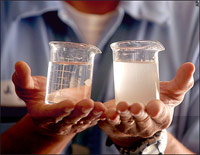Researchers have developed a way of producing drinking water from seawater - that is twice as efficient.
A team from Siemens Water Technologies on Monday received top honors and a $4million grant from the Environment & Water Industry Development Council (EWI).
The council threw a challenge to research institutes and companies last July to develop a desalination technique that used 50 per cent less energy than current methods.
'It hasn't been acheived before, that's why it's a challenge,' said Professor Lui Pao Chuen, chairman of the EWI's evaluation panel.
Siemens beat 35 other groups with its unique spin on desalination.
Using electricity instead of high-pressure or heat to remove salt from seawater, the team produced a metric cube of pure drinking water - with 1.5 kWh.
Advanced desalination methods around the world currently use twice that amount of energy.
Recycled water, also known here as Newater, requires 0.7kWh to produce.
By passing seawater through electric fields, salt is drawn out - the complete opposite of conventional methods which push water through a membrane, explained Siemens vice-president of R&D Ruediger Knauf.
The approach is novel, said PUB technology director Harry Seah.
'It blows convention away,' he said.
Added Prof Lui: 'This is what we call disruptive technology. And it's exactly what we're looking for.'
Siemens will work with national water agency PUB over the next three years to test-bed the technology.
Seawater, though an abundant source, has yet to become a viable water supply for countries worldwide.
Monday's announcement is a prelude to the cutting edge technologies that will be on display at the Singapore International Water Week, which officially opens on Tuesday.
Nearly 400 companies will showcase their products and technologies at the four-day event at the Suntec Convention Centre, to be attended by over 5,000 delegates.

